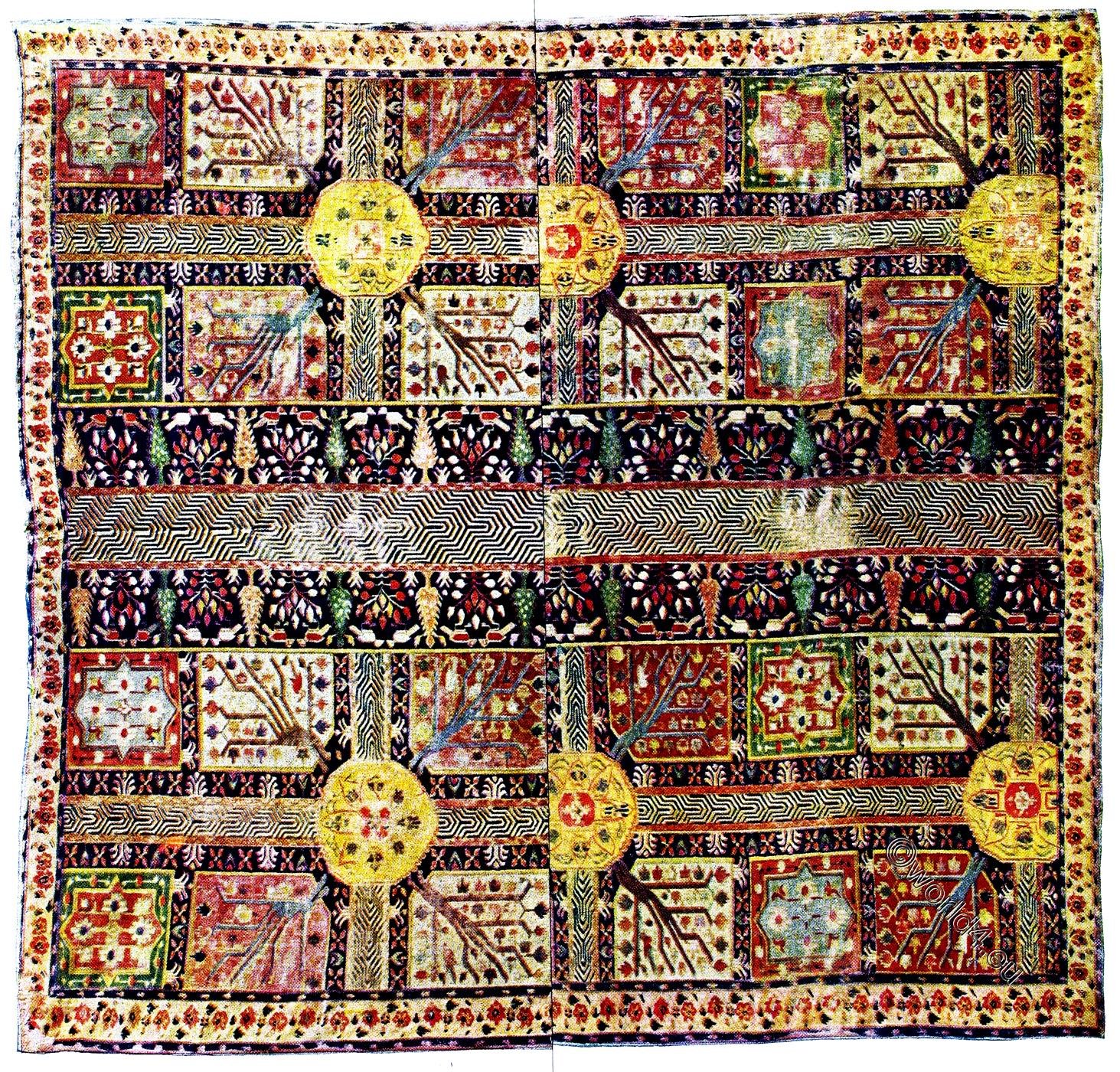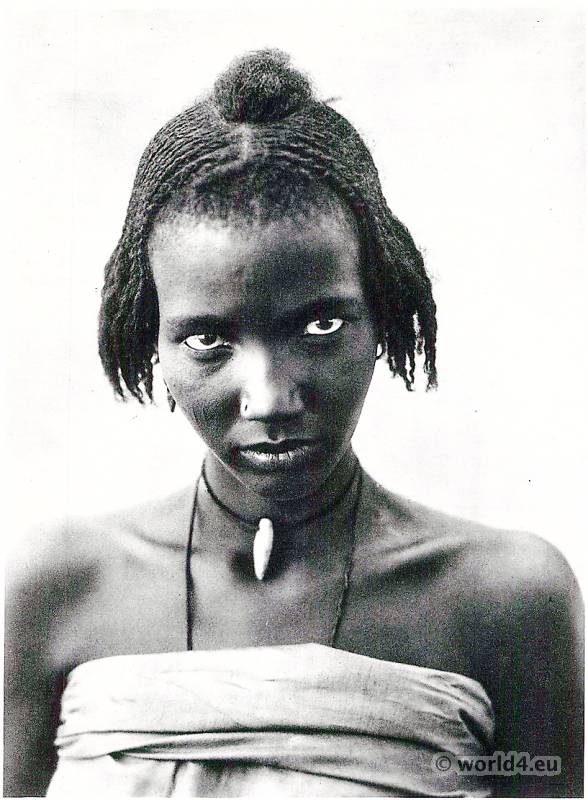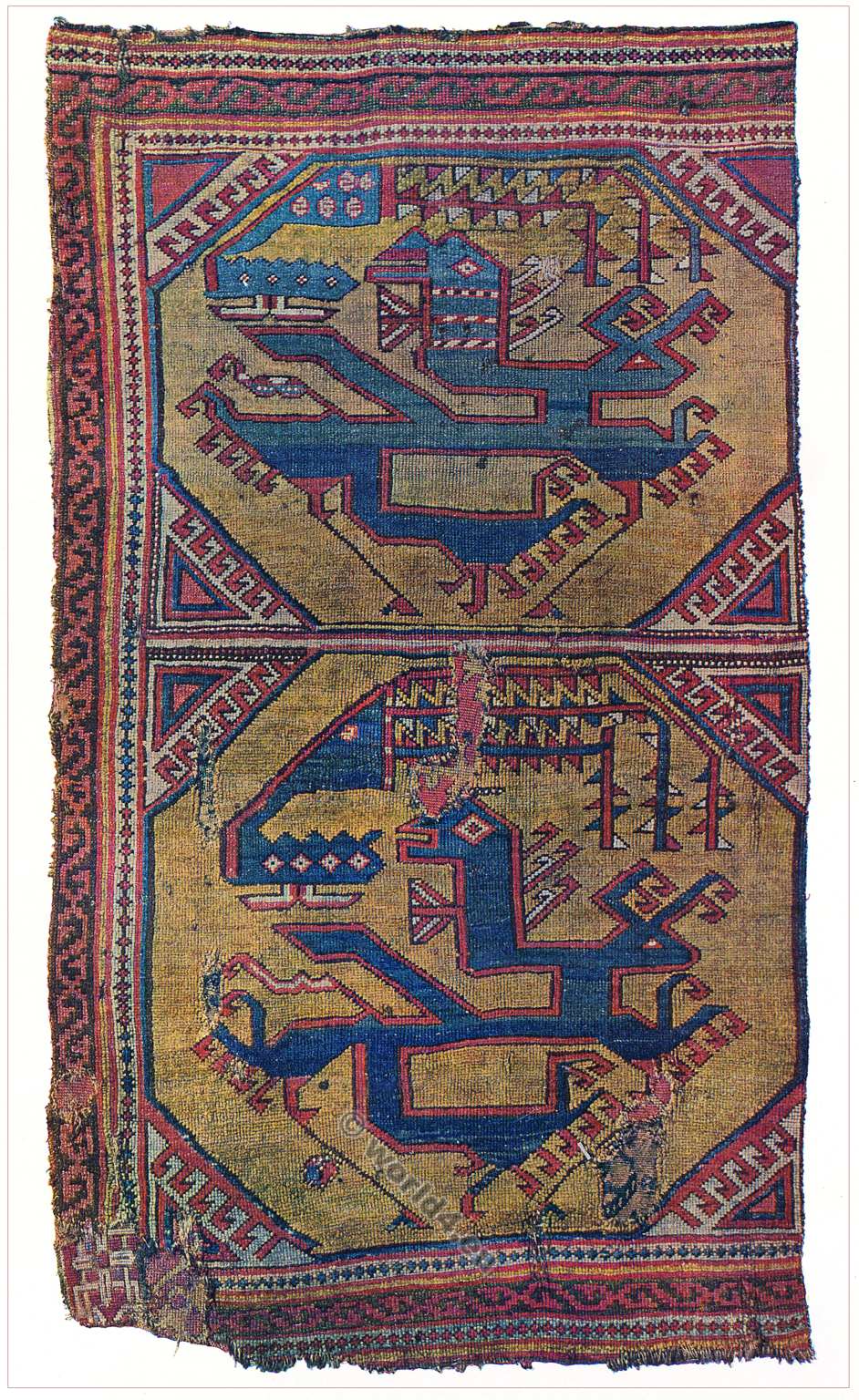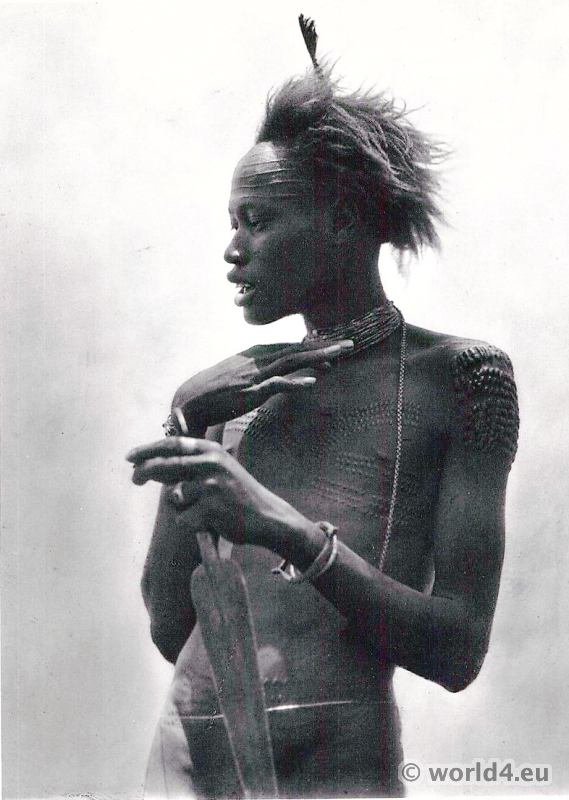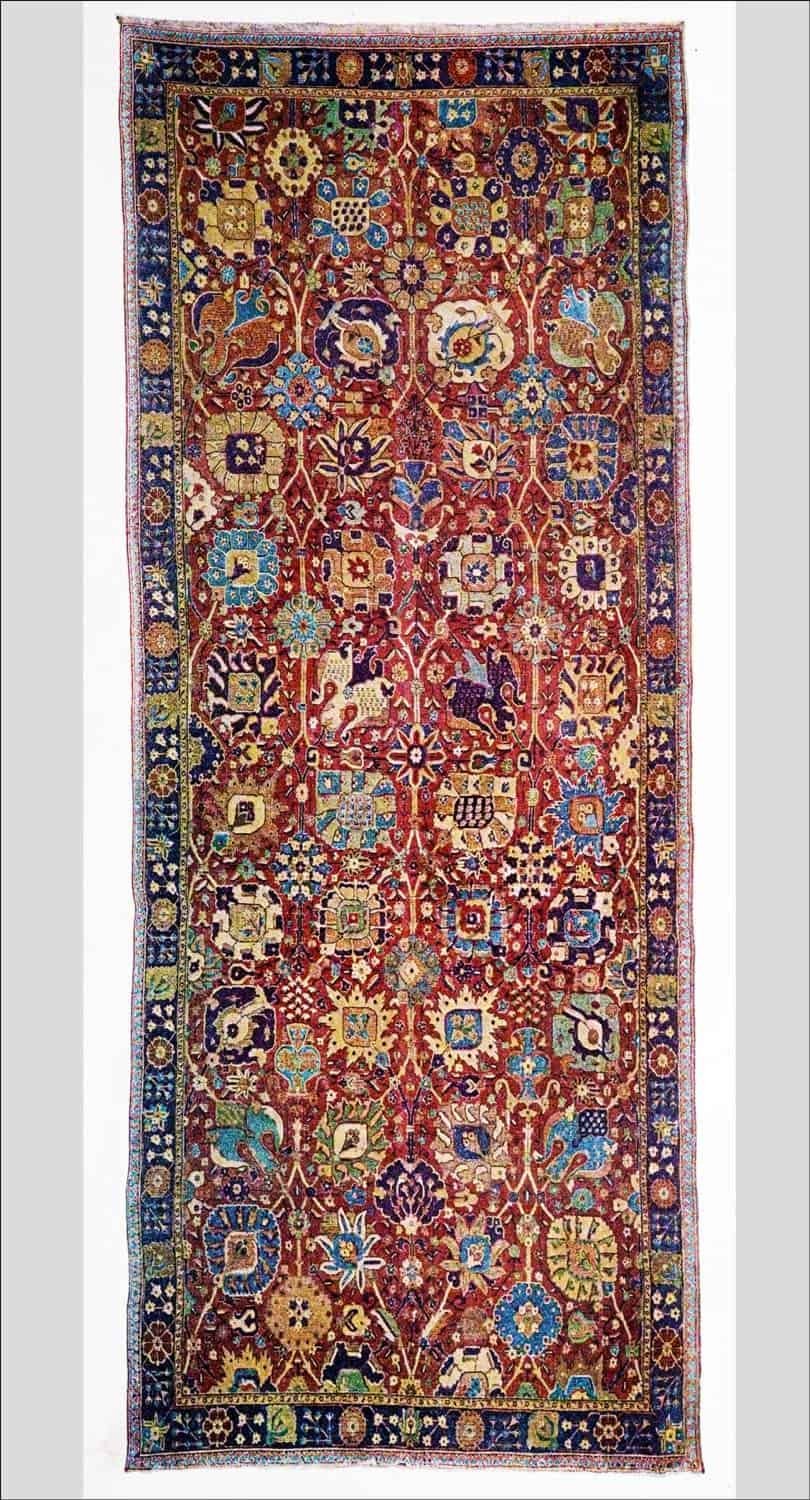Afghan Turkomans.
Turkmen carpets belong to the group of oriental carpets and are made by Turkmen tribes living in the area between the Amudarja River, Caspian Sea, Aral Sea and the border area between the modern states of Iran and Afghanistan. In the visual arts of the Turkmen people many archaic patterns were preserved until the early 20th century.
The original Turkmen were an ancient Persian-speaking people in the steppes of western Central Asia. The wool of Turkmen carpets, typical of nomadic knotting, is of high quality and long pile, using sheep’s wool, goat’s hair and cotton in the basic fabric. The pile is made of wool and sometimes also contains silk. In almost all Turkmen carpets, madder red from dyer madder is the dominant colour. Madder is obtained locally and allows dyeing in different shades. The different tribes dyed in different shades of red. The predominant use of madder red in Turkmen carpets creates a monotonous impression at first glance, but the smaller ornaments are knotted in a variety of colours.
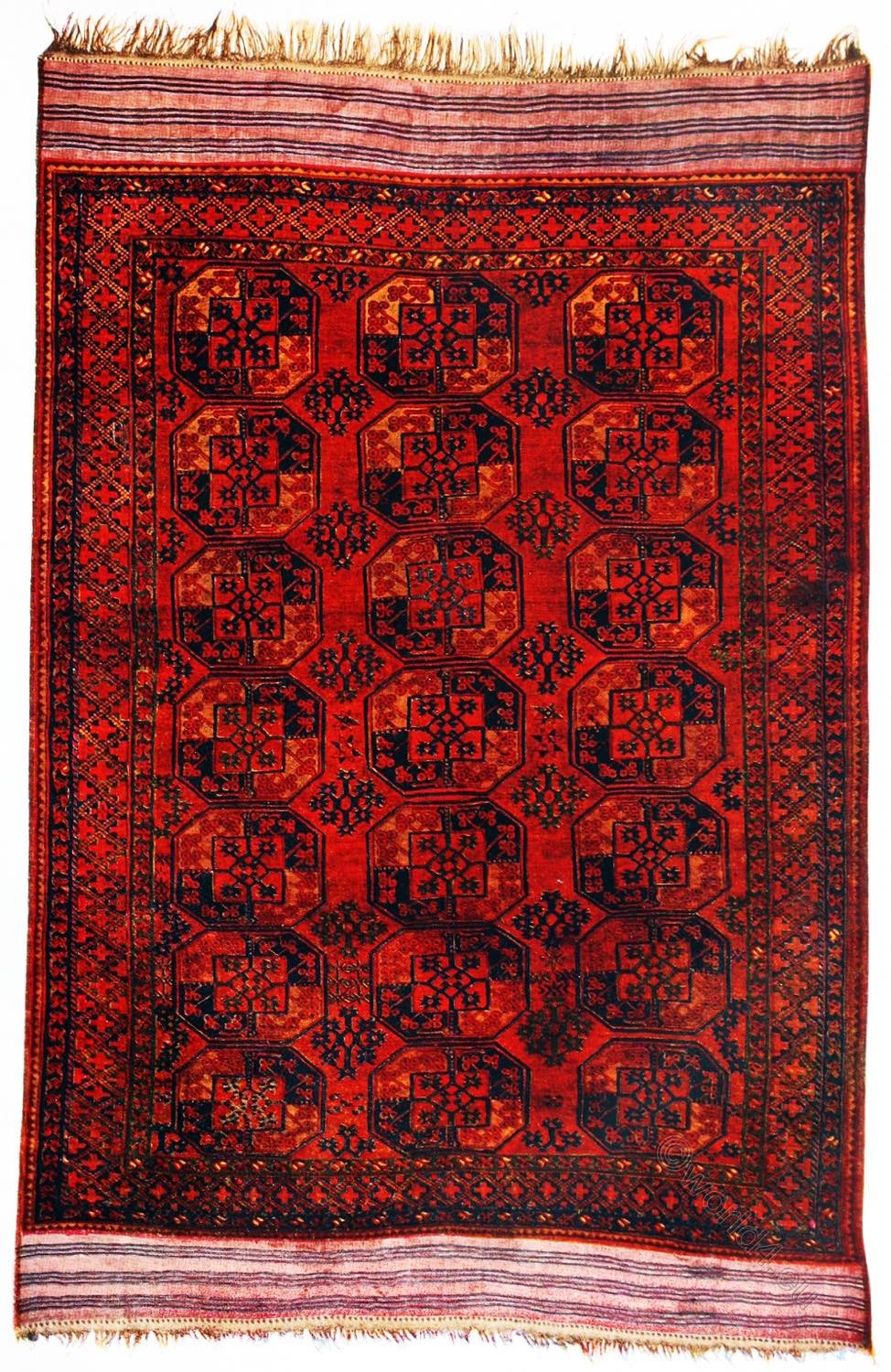
Afghan Filpa Carpet.
CENTRAL ASIAN RUGS BY MAJOR HARTLEY CLARK.
All along the northern frontier of Afghanistan, beyond the Band-i-Turkestan mountain range (Boundary wall of Turkestan, Tīrband-e Torkestān, in northwestern Afghanistan), are woven the carpets known as Afghan Turkomans. They are heavy carpets, somewhat coarse in weave, with a thick pile which is not clipped so close as that of true Turkomans.
Their invariable main field design consists of parallel rows, usually three, of large regular octagons outlined in dark blue on a rich red field, which, in different pieces, varies from blood-red almost to brown.
Top and bottom, these octagons are nearly in contact with each other, and even laterally there is not, as a rule, much space between their sides.
From the size and spacing of these figures, the carpets are known throughout the East as Filpa or Pa-i-fil, meaning Elephant’s Foot, the general effect of the pattern being not unlike the track of an elephant.
The octagons are quartered in the usual Turkoman fashion, the diagonally opposite quarterings being filled with orange, blue, or green, and sometimes white. Generally, there is less white in these carpets than in most Turkomans, but otherwise the general coloring is typically Turkoman.
In the variations of the small designs within the octagons, and between them, when the interstices of the field are not left in plain red, as well as in the borders, the influence of practically every Turkoman tribe finds expression in different pieces. In turn, aU the common minor designs of each Turkoman tribe — Ersari, Tekke, Salor, Saryk, and Yomud — may be featured, but never to such an extent as to alter the unmistakable character of the Filpa.
Naturally enough, these carpets, together with those woolen actually in Afghanistan, art the carpets most plentifully obtainable throughout Afghanistan and Northern India, to which country they come in great abundance in the picturesque camel caravans through the frontier passes.
Few real antiques have survived the very rough treatment to which they were frequently subjected in their own country. There, before carpets had become a mere article of merchandise, as they have done in the last fifty years or more, they were, after they had become too filthy even for the Afghan, doubled at the centre over a rope stretched taut across a river or mountain torrent, and left there several days to be washed clean by the current. After this, they would be taken out, dried in the sun, and finally beaten out with bamboos.
It requires very stout material to withstand many such unmerciful treatments. Added to which the Afghan takes but little trouble to keep his rugs free from moths, “woolly bears,” and other destructive insects, not to mention more disagreeable denizens; nor does he bother to put in that stitch in time which would not only save nine, but would preserve many a beautiful piece of handicraft eventually to reach more appreciative owners.
The carpet illustrated is a particularly line specimen of great age, with a warmth of color that stimulates the eye, and a luxusness of pile that suggests repose.
It is a very pure example of its type in so far as it has not, like so many of its kind, accepted the outside influences and minor designs of other nomad tribes. In the inner quarterings of the octagons of this carpet are seen effulgent stars, which are repeated again in groups of eight in the interstices of the field. The outer quarterings each contain four well-defined trefoil shapes. In the centre of the field, between the octagons, there are two pairs of eight pointed stars, sometimes called the “Seal of Solomon.”
The borders here are very typical, the main border being a conventional geometric design of crosses within diamonds, flanked on the inner and outer sides by narrower borders containing a vine formed by pairs of small cones placed back to back, whilst the extreme outside guard stripe is of the double saw-tooth pattern. Here, too, the alternation of dark blues and dark greens in the pattern is noticeable, as it is in several types of Turkoman rug.
The broad web-ends crossed by narrow stripes of dark blue, and finished by a row of knots and a fringe, are characteristic. The warp of these carpets, and consequently their fringe, is frequently of goat-hair of an unmistakable shade of grey. In all respects of weave, design, and coloring they are thoroughly Turkoman, though never of so fine a texture and seldom of such close-clipped pile as the finest Turkoman rugs.
Truly beautiful old pieces are hard to come by, though this is a very common type of carpet, and the modern product can be bought almost by the acre.
It is curious that the Afghan Turkomans appear to weave no special Ja-i-namaz, or prayer rug; indeed, they seldom weave small rugs at all, the most common sizes being about 10½ feet by 6 feet, or else about 9 feet square.
Although the magnificent carpet of the illustration may be taken as the perfect standard of this group, it would nevertheless be possible for a collector to specialize in this one type and to obtain an infinite variety of minor diversities of design, according as the weavers had come in contact with one or other of the nomad Turkoman tribes.
Source: The Connoisseur. An illustrated Magazine for Collectors. Edited by C. Reginald Grundy. Vol. LXII. (JANUARY—APRIL, 1922). London: Offices of The Connoisseur, AT I, Duke Street, St. James’s 1922.
Continuing
Discover more from World4 Costume Culture History
Subscribe to get the latest posts sent to your email.

